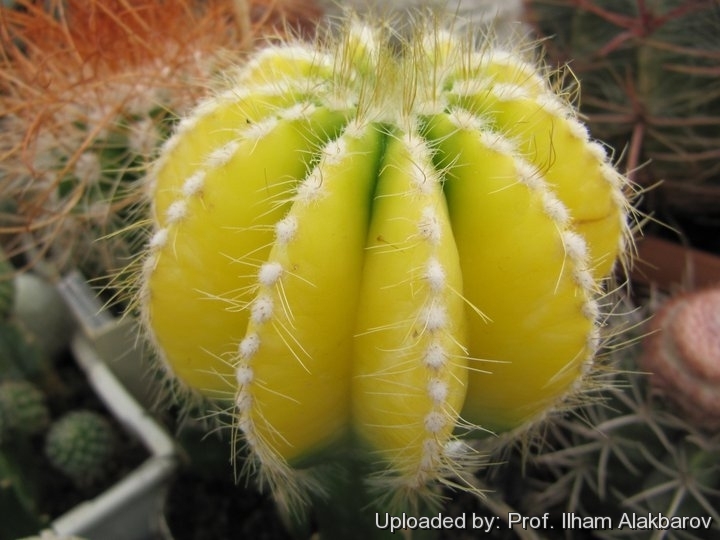= Parodia magnifica f. aurata hort.
Accepted Scientific Name: Parodia magnifica (F.Ritter) F.H.Brandt
Kakteen Orch. Rundschau 7(5): 62. 1982

Eriocactus magnificus f. aurata (Parodia magnifica f. aurata) Photo by: Prof. Ilham Alakbarov
Origin and Habitat: Garden origin (Nursery produced cultivar)
Synonyms:
See all synonyms of Parodia magnifica
back
Accepted name in llifle Database:Parodia magnifica (F.Ritter) F.H.BrandtKakteen Orch. Rundschau 7(5): 62. 1982Synonymy: 6
back
Description: Parodia magnificaSN|20453]]SN|20453]], still known in cultivation with its old name Eriocactus magnificusSN|20454]]SN|20454]], is a bluish-green geometric globular cactus with wool that grows in clusters and produce absolutely brilliant yellow flowers. These cacti develop a slight depression on the crown, which may become distorted with age. Parodia magnificaSN|20453]]SN|20453]] glistens under a haze of pale yellow spines. Cristate (wavy edged) forms are avalible but these are usually grafted plants.
Forma aurea or aurata (Yellow form): The schizochromic form (Parodia magnificaSN|20453]]SN|20453]] f. aurata) has pale yellow stems due to the absence (or reduced production) of chlorophyll pigments: every other pigment is present at normal levels, the dominant green colouration is lost, but will still more than likely have normal other pigments that give the yellow overall appearance of the stem. This plant with yellow stems is very attractive and highly prized. It is almost always seen grafted on stronger columnar species, and cannot can be grown on its own roots. However some clones have enough chlorophyll in their tissues and can be grown on they own roots too, but very slow growing.
Habit: Plants at first solitary, forming large clustering mounds in time.
Stems: Globose, becoming short cylindrical with age, yellow, oblique apically. It grows 30 (or more) cm high and 7-15 cm in diameter.
Ribs: 11-15, straight, symmetrical, acute.
Areoles: White at first, later yellowish close together or almost contiguous.
Spines: 12-15 or more, bristle-like, thin, flexible, goldens yellow, 8-20 mm long.
Flowers: Borne several at a time apically, funnel-shaped, sulphur yellow, 4,5-5,5 cm long and in diameter; pericarpels with dense white wool and brownish bristles.
Blooming season: Flowering occurs in summer through early fall and will bloom several times during warm weather.
Fruits: Globose, pink, to 1 cm in diameter.
Seeds: Obovoid to club shaped, reddish brown, spiny tuberculate.
Subspecies, varieties, forms and cultivars of plants belonging to the Parodia magnifica group
Bibliography: Major references and further lectures
1) Tony Mace “Notocactus: a review of the genus incorporating Brasilicactus, Eriocactus and Wigginsia” Editorial Board/National Cactus & Succulent Society, 1975
2) Edward Anderson “The Cactus family” Timber Press, Incorporated, 2001
3) James Cullen, Sabina G. Knees, H. Suzanne Cubey "The European Garden Flora Flowering Plants: A Manual for the Identification of Plants Cultivated in Europe, Both Out-of-Doors and Under Glass" Cambridge University Press, 11/Aug/2011
4) David R Hunt; Nigel P Taylor; Graham Charles; International Cactaceae Systematics Group. "The New Cactus Lexicon" dh books, 2006
5) Walther Haage “Kakteen von A bis Z” Neumann Verlag, 1981
6) Rosemary McCreary, Sunset Books “Houseplants” Sunset Books, 01/gen/1999
7) Larocca, J. & Machado, M. 2013. Parodia magnifica. In: IUCN 2013. "IUCN Red List of Threatened Species." Version 2013.1. <www.iucnredlist.org>. Downloaded on 29 October 2013.
8) Hiroshi Hirao “Colour encyclopaedia of cacti” Seibundo Shinkosha, 1979
9) Hans Hecht “BLV-Handbuch der Kakteen” BLV-Verlagsgesellschaft, 1982
 Eriocactus magnificus f. aurata (Parodia magnifica f. aurata) Photo by: Prof. Ilham Alakbarov
Eriocactus magnificus f. aurata (Parodia magnifica f. aurata) Photo by: Prof. Ilham AlakbarovSend a photo of this plant.The gallery now contains thousands of pictures, however it is possible to do even more. We are, of course, seeking photos of species not yet shown in the gallery but not only that, we are also looking for better pictures than those already present.
Read More... Cultivation and Propagation: Variegated and albinous cacti are regarded as choice and difficult in cultivation, but despite that many of them are relatively easy to grow. But be aware that they cannot tolerate prolonged exposure to direct sun light (especially during the hottest summer days), so grow them in half-shade or under filtered sun. They are sometime seen as grafted plants, but many grow well on their own roots, too.
On the contrary, the albinos can survive only if grafted on a strong green base.
Use mineral well-permeable substratum with little organic matter (peat, humus). Water sparingly from March till October and keep perfectly dry in winter at temperatures from 5 to 15 degrees centigrade. (In general these plants are more tender and cannot endure freezing temperatures ) In the rest period no high atmospheric humidity!!
Propagation: Usually by seed. Plants are often grafted onto column-shaped cacti.











